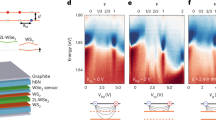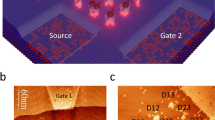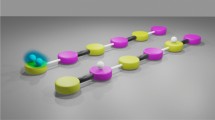Abstract
The Hubbard model constitutes one of the most celebrated theoretical frameworks of condensed-matter physics. It describes strongly correlated phases of interacting quantum particles confined in lattice potentials1,2. For bosons, the Hubbard Hamiltonian has been deeply scrutinized for short-range on-site interactions3,4,5,6. However, accessing longer-range couplings has remained elusive experimentally7. This marks the frontier towards the extended Bose–Hubbard Hamiltonian, which enables insulating ordered phases at fractional lattice fillings8,9,10,11,12. Here we implement this Hamiltonian by confining semiconductor dipolar excitons in an artificial two-dimensional square lattice. Strong dipolar repulsions between nearest-neighbour lattice sites then stabilize an insulating state at half filling. This characteristic feature of the extended Bose–Hubbard model exhibits the signatures theoretically expected for a chequerboard spatial order. Our work thus highlights that dipolar excitons enable controlled implementations of boson-like arrays with strong off-site interactions, in lattices with programmable geometries and more than 100 sites.
This is a preview of subscription content, access via your institution
Access options
Access Nature and 54 other Nature Portfolio journals
Get Nature+, our best-value online-access subscription
$29.99 / 30 days
cancel any time
Subscribe to this journal
Receive 51 print issues and online access
$199.00 per year
only $3.90 per issue
Buy this article
- Purchase on Springer Link
- Instant access to full article PDF
Prices may be subject to local taxes which are calculated during checkout



Similar content being viewed by others
Data availability
Source data are provided with this paper.
References
Salomon, C. et al. Many-Body Physics with Ultracold Gases: Lecture Notes of the Les Houches Summer School: Volume 94, July 2010 (Oxford Univ. Press, 2012).
Arovas, D. P., Berg, E., Kivelson, S. A. & Raghu, S. The Hubbard model. Ann. Rev. Condens. Matter Phys. 13, 239–274 (2022).
Greiner, M., Mandel, O., Esslinger, T., Haensch, T. W. & Bloch, I. Quantum phase transition from a superfluid to a Mott insulator in a gas of ultracold atoms. Nature 415, 39–44 (2002).
Gemelke, N., Zhang, X., Hung, C. L. & Chin, C. In situ observation of incompressible Mott-insulating domains in ultracold atomic gases. Nature 460, 995–998 (2009).
Bakr, W. S. et al. Probing the superfluid-to-Mott insulator transition at the single-atom level. Science 329, 547–550 (2010).
Sherson, J. et al. Single-atom-resolved fluorescence imaging of an atomic Mott insulator. Nature 467, 68–72 (2010).
Baier, S. et al. Extended Bose–Hubbard models with ultracold magnetic atoms. Science 352, 201–205 (2016).
Batrouni, G. G., Scalettar, R. T., Zimanyi, G. T. & Kampf, A. P. Supersolids in the Bose–Hubbard Hamiltonian. Phys. Rev. Lett. 74, 2527 (1995).
Hebert, F. et al. Quantum phase transitions in the two-dimensional hardcore boson model. Phys. Rev. B 65, 014513 (2001).
Goral, K., Santos, L. & Lewenstein, M. Quantum phases of dipolar bosons in optical lattices. Phys. Rev. Lett. 88, 170406 (2002).
Baranov, M. A., Dalmonte, M., Pupillo, G. & Zoller, P. Condensed matter theory of dipolar quantum gases. Chem. Rev. 112, 5012–5061 (2012).
Dutta, O. et al. Non-standard Hubbard models in optical lattices: a review. Rep. Prog. Phys. 78, 066001 (2015).
Trefzger, C., Menotti, C., Capogrosso-Sansone, B. & Lewenstein, M. Ultracold dipolar gases in optical lattices. J. Phys. B 44, 193001 (2010).
Capogrosso-Sansone, B., Trefzger, C., Lewenstein, M., Zoller, P. & Pupillo, G. Quantum phases of cold polar molecules in 2D optical lattices. Phys. Rev. Lett. 104, 125301 (2010).
Fradkin, E., Kivelson, S. A. & Tranquada, J. M. Colloquium: theory of intertwined orders in high temperature superconductors. Rev. Mod. Phys. 87, 457 (2015).
Wise, W. et al. Charge-density-wave origin of cuprate checkerboard visualized by scanning tunnelling microscopy. Nat. Phys. 4, 696–699 (2008).
Jin, C. et al. Stripe phases in WSe2/WS2 moiré superlattices. Nat. Mater. 20, 940–944 (2021).
Lagoin, C., Suffit, S., Baldwin, K., Pfeiffer, L. & Dubin, F. Mott insulator of strongly interacting two-dimensional excitons. Nat. Phys. 18, 149–153 (2022).
Lackner, L. et al. Tunable exciton-polaritons emerging from WS2 monolayer excitons in a photonic lattice at room temperature. Nat. Commun. 12, 4933 (2021).
Seyler, K. L. et al. Signatures of moiré-trapped valley excitons in MoSe2/WSe2 heterobilayers. Nature 567, 66–70 (2019).
Tran, K. et al. Evidence for moiré excitons in van der Waals heterostructures. Nature 567, 71–75 (2019).
Jin, C. et al. Observation of moiré excitons in WSe2/WS2 heterostructure superlattices. Nature 567, 76–80 (2019).
Alexeev, E. M. et al. Resonantly hybridized excitons in moiré superlattices in van der Waals heterostructures. Nature 567, 81–86 (2019).
Kennes, D. M. et al. Moiré heterostructures as a condensed-matter quantum simulator. Nat. Phys. 17, 155–163 (2021).
Gu, J. et al. Dipolar excitonic insulator in a moiré lattice. Nat. Phys. 18, 395–400 (2022).
Remeika, M., Fogler, M. M., Butov, L. V., Hanson, M. & Gossard, A. C. Two-dimensional electrostatic lattices for indirect excitons. Appl. Phys. Lett. 100, 061103 (2012).
Lagoin, C. et al. Microscopic lattice for two-dimensional dipolar excitons. Phys. Rev. B 102, 245428 (2020).
Lagoin, C. et al. Quasicondensation of bilayer excitons in a periodic potential. Phys. Rev. Lett 126, 067404 (2021).
Combescot, M., Combescot, R. & Dubin, F. Bose–Einstein condensation of indirect excitons: a review. Rep. Prog. Phys. 80, 066401 (2017).
High, A. A. et al. Trapping indirect excitons in a GaAs quantum-well structure with a diamond-shaped electrostatic trap. Phys. Rev. Lett. 103, 087403 (2009).
Winbow, A. G. et al. Electrostatic conveyer for excitons. Phys. Rev. Lett. 106, 196806 (2011).
Rosenberg, I., Mazuz-Harpaz, Y., Rapaport, R., West, K. & Pfeiffer, L. Electrically controlled mutual interactions of flying waveguide dipolaritons. Phys. Rev. B 93, 195151 (2016).
Götting, N., Lohof, F. & Gies, C. Moiré-Bose-Hubbard model for interlayer excitons in twisted transition metal dichalcogenide heterostructures. Phys. Rev. B 105, 165419 (2022).
Bissbort, U., Deuretzbacher, F. & Hofstetter, W. Effective multibody-induced tunneling and interactions in the Bose–Hubbard model of the lowest dressed band of an optical lattice. Phys. Rev. A 86, 023617 (2012).
Schmid, G., Todo, S., Troyer, M. & Dorneich, A. Finite-temperature phase diagram of hard-core bosons in two dimensions. Phys. Rev. Lett. 88, 167208 (2002).
Mahmud, K. W. et al. Finite-temperature study of bosons in a two-dimensional optical lattice. Phys. Rev. B 84, 054302 (2011).
Gerbier, F. Boson Mott insulators at finite temperatures. Phys. Rev. Lett. 99, 120405 (2007).
DeMarco, B., Lannert, C., Vishveshwara, S. & Wei, T.-C. Structure and stability of Mott-insulator shells of bosons trapped in an optical lattice. Phys. Rev. A 71, 063601 (2005).
Scholl, P. et al. Quantum simulation of 2D antiferromagnets with hundreds of Rydberg atoms. Nature 595, 233–238 (2021).
Alloing, M., Lemaitre, A., Galopin, E. & Dubin, F. Nonlinear dynamics and inner-ring photoluminescence pattern of indirect excitons. Phys. Rev. B 85, 245106 (2012).
Beian, M. et al. Spectroscopic signatures for the dark Bose–Einstein condensation of spatially indirect excitons. EuroPhys. Lett. 119, 37004 (2017).
Acknowledgements
C.L. and F.D. thank S. Suffit for support during sample fabrication, together with A. Reserbat-Plantey and B. Urbaszek for a critical reading of the manuscript. Work at CNRS was funded by IXTASE from the French Agency for Research (ANR-20-CE30-0032-01). The work at Princeton University (L.P. and K.B.) was funded by the Gordon and Betty Moore Foundation through the EPiQS initiative grant GBMF 9545, and by the National Science Foundation MRSEC grant DMR 1420541. Research at ICFO acknowledges support from ERC AdG NOQIA; Agencia Estatal de Investigación (R&D project CEX2019-000910-S, funded by MCIN/ AEI/10.13039/501100011033, Plan National FIDEUA PID2019-106901GB-I00, FPI, QUANTERA MAQS PCI2019-111828-2, QUANTERA DYNAMITE PCI2022-132919, Proyectos de I+D+I "Retos Colaboración” QUSPIN RTC2019-007196-7); MCIN via European Union NextGenerationEU (PRTR); Fundació Cellex; Fundació Mir-Puig; Generalitat de Catalunya through the European Social Fund FEDER and CERCA programme (AGAUR grant no. 2017 SGR 134, QuantumCAT U16-011424, co-funded by ERDF Operational Programme of Catalonia 2014-2020); the computer resources and technical support at Barcelona Supercomputing Center MareNostrum (FI-2022-1-0042); EU Horizon 2020 FET-OPEN OPTOlogic (grant no 899794); National Science Centre, Poland (Symfonia grant no. 2016/20/W/ST4/00314); European Union’s Horizon 2020 research and innovation programme under the Marie-Skłodowska-Curie grant agreement no. 101029393 (STREDCH) and no. 847648 (‘La Caixa’ Junior Leaders fellowships ID100010434: LCF/BQ/PI19/11690013, LCF/BQ/PI20/11760031, LCF/BQ/PR20/11770012, LCF/BQ/PR21/11840013). R.W.C. acknowledges support from the Polish National Science Centre (NCN) under Maestro grant no. DEC2019/34/A/ST2/00081.
Author information
Authors and Affiliations
Contributions
K.B. and L.P. realized the GaAs bilayer and C.L. and F.D. designed and fabricated the gate electrodes to realize the 250 nm period electrostatic lattice. C.L. and F.D. performed all experiments and data analysis. C.L., U.B., T.G, R.W.C., T.S., M.L., M.H. and F.D. contributed to the theoretical developments. All authors contributed to writing the manuscript. F.D. directed the project.
Corresponding author
Ethics declarations
Competing interests
The authors declare no competing interests.
Peer review information
Peer review information
Nature thanks the anonymous reviewers for their contribution to the peer review of this work.
Additional information
Publisher’s note Springer Nature remains neutral with regard to jurisdictional claims in published maps and institutional affiliations.
Extended data figures and tables
Extended Data Fig. 1 Theoretical hallmarks of CB order.
a, Lowest band structure factor S1(k) at T=100 mK obtained by exact diagonalisation of a 8 site square lattice (Betts cluster) with periodic boundary conditions. It exhibits a dominant peak at quasi-momentum k = (π/a, π/a), which is a characteristic signature of CB order. A second strongly suppressed quasi-peak lies at k = (0, 0) (due to finite size effects), corresponding to a homogenous liquid without any density order. b, ∣S1(π/a, π/a)∣ (black) and ∣S1(0, 0)∣ (blue) are plotted versus temperature T. Up to T ≲ Tc = 420 mK, the structure factor signalling CB order remains at least twice as large as the structure factor for a homogeneous liquid. c, CB order parameter deduced from mean-field calculations as a function of the chemical potential μ and temperature (T = 4, 125, 247, 389, 450 mK in blue, violet, black, red and green respectively). The order parameter is given by the population difference ∣nA − nB∣ between two sub-lattices, A and B, of the square lattice. Below around 410 mK ∣nA − nB∣ is significant manifesting CB order.
Extended Data Fig. 2 Spatially resolved PL intensity and intensity fluctuations.
a, Spatial variations of the PL intensity \(\overline{{A}_{\max }}\) (black line) and \(\sigma ({A}_{\max })/\overline{{A}_{\max }}\) (violet bars) measured at T = 330 mK and P = 17 nW, that is for the MI phase. Both \(\overline{{A}_{\max }}\) and \(\sigma ({A}_{\max })/\overline{{A}_{\max }}\) vary weakly in the 3 μm central region of the laser excited region, evidencing that the MI phase is homogeneous across more than 100 lattice sites. Outside this region we note that \(\sigma ({A}_{\max })/\overline{{A}_{\max }}\) increases steeply while \(\overline{{A}_{\max }}\) drops, which signals that excitons realise a normal fluid. b, Same measurements obtained for P = 8.2 nW, that is for the CB phase. Results are extracted from the experiments reported in Fig. 2.
Extended Data Fig. 3 Exciton compressibility versus average lattice filling.
Fluctuations of the maximum of the PL intensity (\(\sigma ({A}_{\max })/\overline{{A}_{\max }}\)) as a function of the power P of the loading laser, in a different region of our two-dimensional square lattice. As for Fig. 2, experimental results are obtained by statistically analysing a series of 10 measurements for every value of P. The laser excitation profile was set close to the one for the experiments shown in Fig. 2. Remarkably we recover that two insulating phases emerge for P = 7 and 14.4 nW, in good agreement with the findings discussed in the main text. Experiments were realised at T = 330 mK; error bars display statistical confidence while the level of Poissonian fluctuations is given by the grey shaded region.
Extended Data Fig. 4 Residuals at \(\bar{n}=\) 1/2 and 1.
a, PL spectrum measured at \(\bar{n}\)=1/2 (top) together with the modelled profile (black line). The bottom panel displays the residuals between modelled and measured profiles (black line), compared to the amplitude of poissonian fluctuations (grey area). b, Same measurements for \(\bar{n}\)= 1. Experimental results are taken from the data reported in Fig. 2b–d.
Rights and permissions
Springer Nature or its licensor holds exclusive rights to this article under a publishing agreement with the author(s) or other rightsholder(s); author self-archiving of the accepted manuscript version of this article is solely governed by the terms of such publishing agreement and applicable law.
About this article
Cite this article
Lagoin, C., Bhattacharya, U., Grass, T. et al. Extended Bose–Hubbard model with dipolar excitons. Nature 609, 485–489 (2022). https://doi.org/10.1038/s41586-022-05123-z
Received:
Accepted:
Published:
Issue Date:
DOI: https://doi.org/10.1038/s41586-022-05123-z
This article is cited by
-
Valley-polarized excitonic Mott insulator in WS2/WSe2 moiré superlattice
Nature Physics (2024)
-
Dipolar quantum solids emerging in a Hubbard quantum simulator
Nature (2023)
-
Dipole ladders with large Hubbard interaction in a moiré exciton lattice
Nature Physics (2023)
-
Simple solids can mimic complex electronic states
Nature (2022)
-
Dual-density waves with neutral and charged dipolar excitons of GaAs bilayers
Nature Materials (2022)
Comments
By submitting a comment you agree to abide by our Terms and Community Guidelines. If you find something abusive or that does not comply with our terms or guidelines please flag it as inappropriate.



